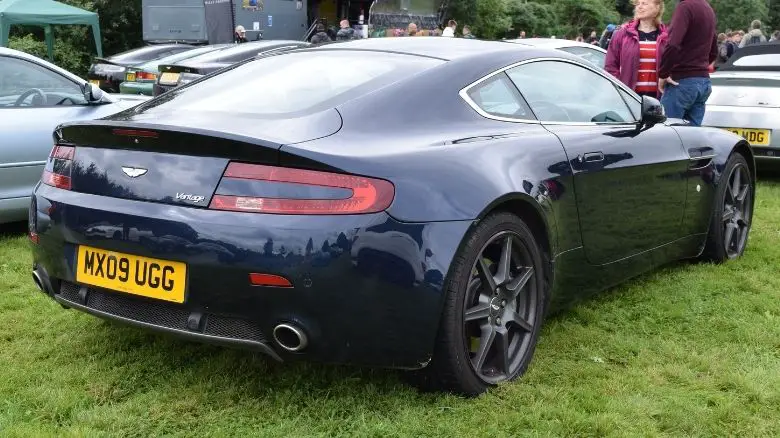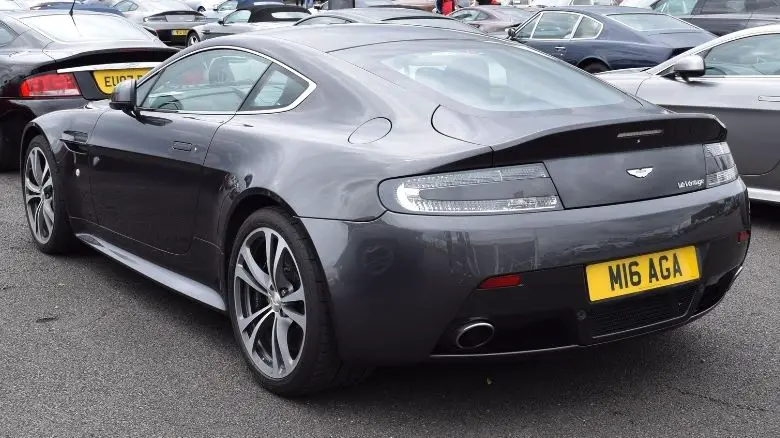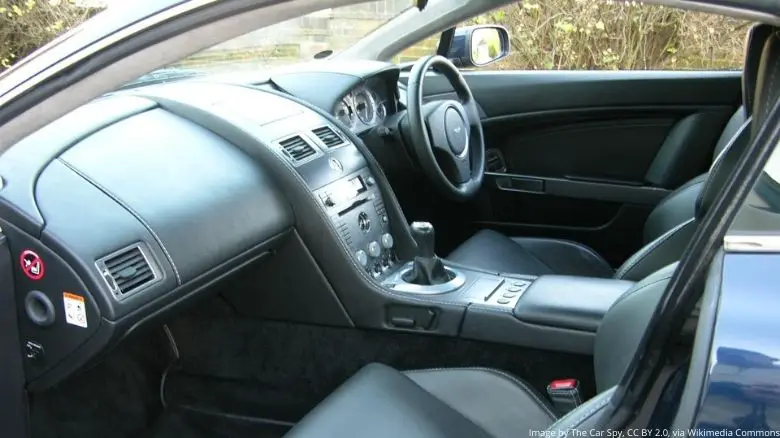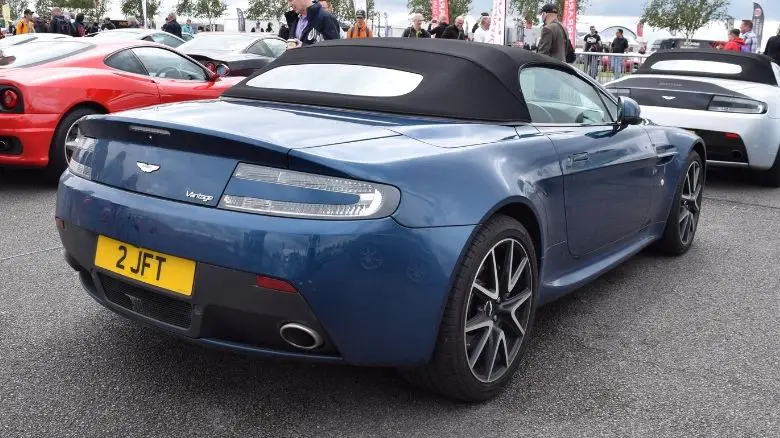Aston Martin Vantage (2005-2017): The Last Analog Aston That's Already a Classic

Adam Chinn
Founder, The Car Investor
Aston Martin's V8 and V12 Vantage models from the 2005-2017 era represent some of the most desirable Aston Martins ever created, combining accessibility with genuine exotic car character in ways that seem impossible in today's market.
No longer a question of "will they be classics," these Vantages have already achieved recognition as modern classics, with market appreciation validating their significance as the last naturally aspirated Aston Martins and potentially the final analog supercars from the storied British marque.
Affectionately known as the 'Baby Aston' when launched in 2005, the second-generation Vantage democratized Aston Martin ownership while maintaining the brand's essential character of beauty, performance, and exclusivity.
So, given current market evidence, has the Aston Martin Vantage achieved classic status?
The Aston Martin Vantage has definitively achieved classic car status thanks to its impressive performance, sublime handling, and the intoxicating roar of its naturally aspirated engines.
It represents everything wonderful about pre-electrification sports cars while offering genuine exotic car experiences at relatively accessible pricing.
The Aston Martin Vantage: A Revolutionary History
The 'Vantage' nameplate carries significant heritage throughout Aston Martin's history, but the 2005-2017 generation created something unprecedented: an Aston Martin that enthusiasts could actually afford.
The VH2 platform Vantage represented Aston's first serious attempt at volume production (by their standards), offering smaller, lighter packaging than the DB9 while maintaining the luxury and performance expected from the marque.
Initial V8 specification featured a 4.3-liter naturally aspirated V8 producing 380 horsepower, later enhanced to a 4.7-liter unit delivering 420 horsepower in 2008. These engines provided not just power but the visceral soundtrack that defines the Aston Martin experience.

The 2009 V12 variant elevated the concept further with a 5.9-liter V12 producing 510 horsepower, creating what many consider one of the greatest Aston Martins ever built. This engine represented the pinnacle of naturally aspirated technology before emissions regulations forced industry-wide downsizing.
Production concluded in 2017 with the arrival of an all-new turbocharged Vantage, marking the end of an era for naturally aspirated Aston Martins and analog driving experiences.
Performance That Defines an Era
Advertisement
The V8 Vantage delivers 0-60 mph in 4.8 seconds, while the V12 variant achieves the sprint in under 4 seconds—figures that remain impressive by contemporary standards while delivering the linear power characteristics extinct in modern turbocharged alternatives.
Beyond straight-line performance, the Vantage earned recognition for exceptional handling balance and nimble road manners that distinguished it from larger, heavier supercars. This combination of accessibility and capability created unique appeal among driving enthusiasts.
The naturally aspirated engines provide experiences impossible to replicate with modern forced induction. The V8's growl and V12's scream represent automotive symphonies that emissions regulations have silenced in contemporary offerings.
Country road capability exceeds many dedicated sports cars, with the Vantage's balanced chassis and communicative steering creating genuine driver engagement through challenging technical sections.
The V12: Automotive Perfection Realized
The 2009 V12 Vantage represents the absolute pinnacle of the model line, combining 510 horsepower with Aston Martin's most characterful engine in their most focused chassis.

Production rarity of just 3,052 total V12 Vantages (including Vantage S and ultra-rare AMR variants) creates genuine exclusivity that supports premium values and collector interest.
Performance credentials place the V12 among the most capable sports cars of any era, while the naturally aspirated delivery provides experiences that no modern alternative can match.
Cultural significance was cemented through memorable Top Gear sequences and widespread critical acclaim that established the V12 Vantage as a benchmark for analog supercar excellence.
Current market dynamics show V12 models commanding double the pricing of V8 variants, reflecting recognition of their ultimate status within the Vantage hierarchy.
Ownership Reality and Running Costs
Advertisement
Aston Martin ownership traditionally involves premium maintenance costs, and the Vantage maintains this expectation while proving more reliable than many exotic alternatives.
Engine durability receives positive owner feedback when proper maintenance schedules are followed, with both V8 and V12 units proving robust despite their high-performance nature.
Known issues include transmission problems (particularly early automatics) and electrical gremlins typical of British luxury cars, though these remain manageable for committed owners.
Maintenance philosophy requires acceptance of premium costs while understanding that proper care prevents more expensive problems. Using Aston Martin specialists or main dealers ensures appropriate expertise.
Daily usability exceeds many exotics, making the Vantage viable as regular transportation while building investment potential through careful use.
Market Transformation: From Depreciation to Appreciation
The 2010s depreciation period created extraordinary opportunities, with quality V8 Vantages available for $35,000/£25,000—pricing that now seems impossibly cheap.
Current market reality shows dramatic appreciation across all variants, with decent examples now commanding $60,000-100,000+ depending on specification, condition, and mileage.
Natural aspiration significance has become crucial to values as emissions regulations eliminate such engines from new car production, making the Vantage increasingly irreplaceable.
Post-2008 models with the 4.7-liter V8 command premiums over early 4.3-liter cars, reflecting improved reliability and enhanced performance that collectors prefer.
Investment timing has shifted from speculative to established, with quality examples demonstrating consistent appreciation while remaining more accessible than newer alternatives.
Production Numbers and Rarity Analysis
Advertisement
Total production of 24,700 Vantages over 12 years creates sufficient rarity for collectible status while ensuring reasonable availability for enthusiastic buyers.
Coupe variants generally command premiums over roadsters for their structural purity and racing connections, though both body styles offer distinct appeal.
AMR variants represent the ultimate collector specifications with minimal production numbers and enhanced performance that create significant premiums.
Classic Car Credentials Analysis
Rarity Factor
Hand-built production at Aston Martin's Warwickshire facility ensures genuine exclusivity compared to mass-produced alternatives. While not the rarest Aston Martin, 24,700 examples create perfect classic car scarcity.
Unique Characteristics
Naturally aspirated engines distinguish the Vantage from all contemporary and subsequent alternatives, providing irreplaceable experiences as forced induction becomes universal.
Design excellence creates timeless aesthetics that age gracefully while maintaining distinctive Aston Martin DNA that ensures lasting visual appeal.
Performance capability remains impressive by modern standards while delivering analog engagement that newer cars cannot replicate despite superior specifications.
Fashion and Desirability
Continued relevance at car shows and events demonstrates lasting appeal that transcends generational preferences and automotive fashion cycles.
Timeless design principles ensure the Vantage avoids the dated appearance that affects many contemporary sports cars, maintaining visual freshness years after production ended.
Cultural significance through media appearances and critical acclaim creates lasting recognition that supports classic car status.

Maintenance Considerations
Exotic car costs remain manageable compared to more exclusive alternatives while delivering genuine supercar experiences that justify premium ownership expenses.
Specialist networks provide comprehensive support for maintenance and restoration, ensuring long-term ownership viability for committed enthusiasts.
Parts availability benefits from Aston Martin's ongoing support and shared components with other models, preventing the supply issues that affect some classics.
Investment Strategy and Selection Guidance
Post-2008 4.7-liter V8 models represent the sweet spot for most buyers, combining improved reliability with enhanced performance while remaining relatively accessible.
V12 variants offer ultimate collectible potential for those with larger budgets, providing maximum exclusivity and performance within the Vantage range.
Service history matters more than mileage for these robust cars, with comprehensive maintenance records indicating responsible ownership and future reliability.
Originality preservation becomes increasingly important as modified examples struggle to achieve the appreciation of unmolested cars in maturing classic markets.
Market timing favors current action over waiting, as quality examples continue appreciating while selection narrows through collector recognition.
Future Outlook: Classic Status Confirmed
The Vantage represents the end of an automotive era - the last naturally aspirated Aston Martin and potentially the final analog supercar from the marque before electrification transforms the industry.
Market evidence confirms classic car transition through sustained appreciation, collector recognition, and growing scarcity of quality examples.
Generational appeal ensures lasting demand as buyers who coveted these cars during their depreciation years now possess the means to acquire them.

Technological significance grows as naturally aspirated engines become historical artifacts, making the Vantage's character increasingly irreplaceable.
Investment perspective has shifted from speculative to established, with quality examples providing both exceptional ownership experiences and solid financial foundations.
The Verdict: Modern Classic Achievement
The Aston Martin Vantage has successfully completed its transformation from depreciating exotic to recognized modern classic, validating its engineering excellence and design timelessness.
For enthusiasts, the Vantage offers authentic Aston Martin experiences at pricing that remains accessible compared to newer alternatives while providing analog engagement that modern cars cannot match.
For collectors, established appreciation trends and growing recognition make quality Vantages compelling investments that combine emotional satisfaction with financial returns.
The bottom line: The Vantage achieved something remarkable - it democratized Aston Martin ownership while maintaining the brand's essential character. Its evolution into classic status represents automotive history validating exceptional engineering and design.
Classic car insight: The Vantage proves that accessibility and exclusivity aren't mutually exclusive when execution reaches the highest standards. Sometimes the most attainable examples of greatness become the most treasured.

About the Author
Adam Chinn is the founder of The Car Investor, combining his passion for classic cars with data-driven investment strategies to help collectors maximize their returns.
View all articles →Related Articles

Volvo 850 T-5R: The Sleeper That Shocked the Performance World
The Volvo 850 T-5R and 850 R have evolved from unconventional performance cars to cherished modern classics, representing one of the most successful transformations of a conservative brand into a genuine performance force.

Alfa Romeo 147 GTA: The Beautiful Lunatic That Defied Logic
The Alfa Romeo 147 GTA stands as automotive proof that passion can triumph over practicality, creating one of the most characterful and increasingly valuable hot hatchbacks ever built.

Will the Jaguar F-Type Become a Classic?
The Jaguar F-Type represents a fascinating case study in modern classic car potential. Launched in 2013 as Jaguar's spiritual successor to the legendary E-Type, the F-Type marked the British marque's return to dedicated sports car manufacturing after a 40-year hiatus.
Advertisement